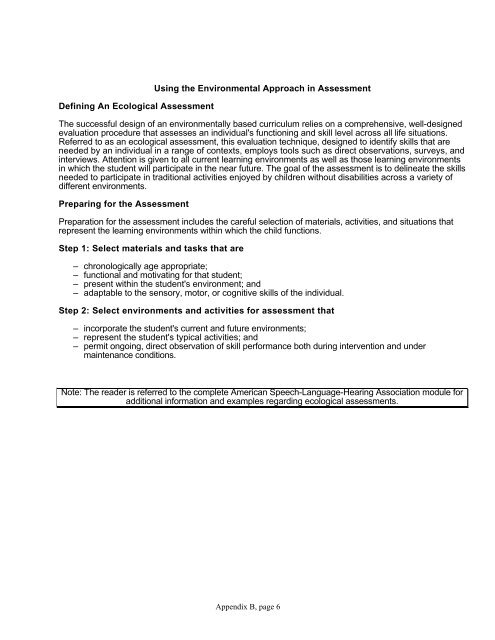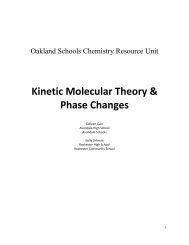Oakland Schools ASSISTIVE TECHNOLOGY GUIDELINES
Oakland Schools ASSISTIVE TECHNOLOGY GUIDELINES
Oakland Schools ASSISTIVE TECHNOLOGY GUIDELINES
Create successful ePaper yourself
Turn your PDF publications into a flip-book with our unique Google optimized e-Paper software.
Defining An Ecological Assessment<br />
Using the Environmental Approach in Assessment<br />
The successful design of an environmentally based curriculum relies on a comprehensive, well-designed<br />
evaluation procedure that assesses an individual's functioning and skill level across all life situations.<br />
Referred to as an ecological assessment, this evaluation technique, designed to identify skills that are<br />
needed by an individual in a range of contexts, employs tools such as direct observations, surveys, and<br />
interviews. Attention is given to all current learning environments as well as those learning environments<br />
in which the student will participate in the near future. The goal of the assessment is to delineate the skills<br />
needed to participate in traditional activities enjoyed by children without disabilities across a variety of<br />
different environments.<br />
Preparing for the Assessment<br />
Preparation for the assessment includes the careful selection of materials, activities, and situations that<br />
represent the learning environments within which the child functions.<br />
Step 1: Select materials and tasks that are<br />
– chronologically age appropriate;<br />
– functional and motivating for that student;<br />
– present within the student's environment; and<br />
– adaptable to the sensory, motor, or cognitive skills of the individual.<br />
Step 2: Select environments and activities for assessment that<br />
– incorporate the student's current and future environments;<br />
– represent the student's typical activities; and<br />
– permit ongoing, direct observation of skill performance both during intervention and under<br />
maintenance conditions.<br />
Note: The reader is referred to the complete American Speech-Language-Hearing Association module for<br />
additional information and examples regarding ecological assessments.<br />
Appendix B, page 6
















